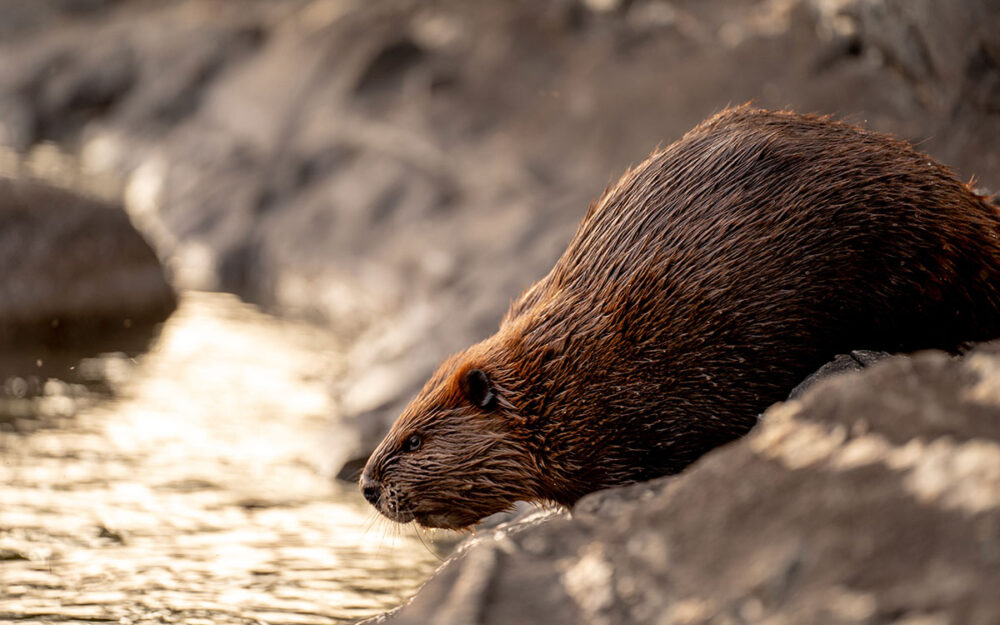
It’s taken years of drought and intense wildfires for California officials to recognize that the state’s current water management system is underprepared to meet the needs of its changing climate. For many wetland conservationists, water managers, and especially California Indigenous water protectors, one solution has always been at hand—bring in the beavers.
New state funding is boosting a restoration program to help relocate beavers to areas in need of wetland conservation. This is one of the many efforts legislators and state departments are now focusing on to advance climate resilience—and will reveal how beavers are beneficial, not detrimental, to California’s waters and lands.
Beavers are. . .critical in helping coho and Chinook salmon reach their spawning streams by keeping their habitats intact. These fish are an essential food source for Winnemem Wintu, Karuk, Hoopa Valley, and Yurok“They are the best engineers that we could possibly hire in order to help us with watershed management, and we need them, for many reasons,” says Sherri Norris, the executive director of the California Indian Environmental Alliance, a nonprofit coordinating 34 California tribes working toward environmental action and justice. “[Beavers] are a part of the natural landscape, they align with the governor’s 30×30 plan, and they are a part of nature-based solutions.”
California’s Beaver Beginnings
Beavers, or castor canadensis, have been a part of the California environment for at least as long as the land has had people. Beavers have long been recognized as native to the San Joaquin watershed and the High Sierra, but recent studies also show their range has also historically included coastal areas. These semiaquatic rodents build dams that flood areas that might have dried up otherwise—making them essential to many watersheds and wetlands.
Beavers are also critical in helping coho and Chinook salmon reach their spawning streams by keeping their habitats intact. These fish are an essential food source for Winnemem Wintu, Karuk, Hoopa Valley, and Yurok tribes.
After a significant decline in population in the 19th century due to unregulated, rampant fur trapping and habitat loss, beaver numbers remained low in the state until the early 20th century, when their population grew from 1,300 to 20,000, in part due to successful relocation.
The Push to Bring Beavers Back
The push to bring beavers back is long overdue, as these animals naturally help fight climate change with their engineering expertise.
Community-based efforts have been advocating for beaver relocation for over a decade. For example, in 2009, the Occidental Arts and Ecology Center in partnership with the WATER Institute launched the Bring Back the Beaver campaign in Sonoma County. The campaign partners with California tribes and other stakeholders to promote and implement beaver habitat restoration. For some tribes—such as the Tule River Indian tribe in Tulare County and the Maidu Summit Consortium near Lake Almanor in northeastern California—beavers, and beaver mimicry, are necessary parts of holistic land restoration.
A coalition of organizations, including the WATER Institute and CIEA, successfully advocated for the California Department of Fish and Wildlife to start a beaver restoration program. State funding is now going to over 30 agencies and nonprofit organizations with overlapping goals of rebalancing the waterways for healthier fish populations and wetland regeneration.
For the 2023-2024 fiscal year, CDFW was approved to receive $1.4 million from the state budget to hire several scientists to work on a comprehensive approach to beaver management as part of the restoration program, explains Jason Holley, CDFW Beaver Restoration Program Manager. Scientists plan to collaborate with partners to relocate beavers into watersheds where their dams can have positive environmental impacts, such as helping to restore hydrologic connectivity, creating and improving habitat for other species, increasing groundwater recharge, and promoting resilience to climate change and wildfire.
Additional regulatory efforts are aimed at making it easier for beavers to have a chance at successful relocation. In 2019, the state outlawed recreational and commercial trapping of fur-bearing animals. In addition, it is illegal for citizens to possess or transport a beaver, unless authorized by CDFW. However, current California law allows killing beavers if found on private property. Part of the new CDFW program will assess the current laws to understand if and where revisions need to be made to protect beavers relocated back to the area.
Sign up for our free newsletters
Subscribe to NPQ's newsletters to have our top stories delivered directly to your inbox.
By signing up, you agree to our privacy policy and terms of use, and to receive messages from NPQ and our partners.
These laws point to one reason beavers may not thrive in an area: conflict with humans. The increased funding for CDFW supports collaboration between property owners and beaver restoration program staff and other partners to explore new and improved coexistence techniques. These techniques include preventing competition for beavers by moving cattle and other livestock, actively reinforcing beaver dams, or enhancing the habitats they’ve started building.
When coexistence fails, relocation becomes the next option. Currently, there are many opportunities to move beavers to parts of the state where they had been previously wiped out, or where they could support other efforts. For example, the CIEA works with a salmon restoration group in the Sacramento and San Joaquin regions that catalog the areas in need of salmon restoration. “[Relocating] beaver [in those areas] is one of those strategies we are recommending,” she says.
Beaver Plans and Beaver Dams
“We have been pushing California to embrace beavers for 10 years now and asked them specifically to build a beaver management plan, but there hasn’t been the will or the capacity,” says Lundquist. So, what changed to establish this new program under CDFW?
Education at the higher levels of government. After years of and direct political advocacy and studies showing how climate-change related drought and fire events impacted diverse habitats across the state, politicians and legislators began to understand the necessity of using nature-based solutions to combat desertification—beavers included.
In 2019, the WATER Institute, along with the Center for Biological Diversity and the Environmental Protection Information Center, petitioned the California Fish and Game Commission to amend the code on beaver depredation to require land owners to exhaust all nonlethal methods before killing beavers. They also petitioned to take into consideration any listed species that might be harmed by beaver removal if a depredation permit is issued.
The possibility to amend the codes is now folded into the larger beaver restoration plans with the department. Reviewing the codes will coincide with piloting the beaver relocation plan.
The groups involved in these projects remain hopeful, especially with ongoing funding of state programs. According to Holley, a 2019 project with the Scott River Watershed Council in Siskiyou County is evaluating the effects of beaver dam analogues and if they influence the growth and survival of salmon.
The CDFW is embracing the paradigm shift around beavers and is working to bring together collective knowledge for a comprehensive approach to beaver management and restoration efforts, he says.
“Scientists are confident that beaver restoration has the potential to be a nature-based solution that can aid in reducing wildfire risk, mitigating drought, and combating climate change,” explains Holley. This is another piece in the puzzle as CDFW works to implement solutions to some of California’s greatest environmental challenges.













